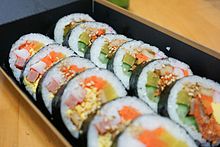海苔飯捲
韓式海苔卷
此條目可參照英語維基百科相應條目來擴充。 (2020年8月1日) |
海苔飯捲(韓語:김밥,羅馬化:gimbap,中國大陸稱為紫菜包飯,香港稱為紫菜捲飯)[1],是一種流行的朝鮮食品[2],是將蒸熟的白米飯和各種其他材料捲進紫菜中,再切成一塊塊供應。[3]紫菜包飯通常在野餐或戶外活動時吃,或作為簡便的午餐,佐以蘿蔔乾或泡菜。[4]
| 紫菜包飯 | |
 一盤紫菜包飯切片 | |
| 韓語名稱 | |
|---|---|
| 諺文 | 김밥 |
| 文觀部式 | gimbap |
| 馬-賴式 | kimbap |

朝鮮日治時期,日本的捲壽司(巻き寿司)傳入朝鮮半島[5][6][7][8][9]。朝鮮人在日本壽司的基礎上發展出紫菜包飯。雖然外型跟日本壽司捲相像,紫菜包飯在調味或製作上的主要差異存在於,一,紫菜包飯的海苔通常會用芝麻香油均勻的抹在上面以散發香味,二,米飯通常為原味而不會加醋調味。三,餡料日本多使用魚肉,韓國則是以豬肉為主,並會加辣醬或泡菜等辛辣與醃漬食材,也因為餡料更多達三四種以上而明顯比較粗。
小捲的紫菜包飯通常並不切片。另外紫菜包飯也有類似日式飯糰的變種,稱三角紫菜包飯(韓語:삼각김밥/三角김밥)。
紫菜捲飯在韓國很便宜且容易買到,一般在韓國的小吃店等地中,1000至2000韓元左右就可以買到紫菜捲飯。紫菜包飯品種眾多,老少皆宜。所以很受東南亞地區人們的歡迎。
參考資料
編輯- ^ (韓語) 주요 한식명(200개) 로마자 표기 및 번역(영, 중, 일) 표준안 (PDF). 韓國國立國語院. 2014-07-30 [2017-02-15]. (原始內容存檔 (PDF)於2019-01-23).
- ^ Kimbap (頁面存檔備份,存於網際網路檔案館), excerpt from Andrew J. Luxner's American English: A Teachers's Journey in Seoul, South Korea. Golden Hill Books, San Diego. ISBN 0-9760748-1-8
- ^ Gimbap[失效連結], 斗山世界大百科(韓文)
- ^ Gimbap 網際網路檔案館的存檔,存檔日期2012-03-24., Encyclopedia of Korean Culture(韓文)
- ^ Levinson, David; Christensen, Karen. Encyclopedia of Modern Asia: China-India relations to Hyogo. Charles Scribner's Sons. 2002 [2016-06-06]. ISBN 0-684-80617-7. (原始內容存檔於2019-06-20).
This process was initiated during the Japanese occupation (1910-1945), when Western food and drink, such as bread, confectionery, and beer, became popular in Korean cities, and a Western-style food processing industry in Korea began. Some Japanese food items were also adopted into Korean cuisine at that time, such as tosirak (the assorted lunch box) and sushi rolled in sheets of seaweed, which was popular in Korea under the name of kimbap.
- ^ Brunner, Anne. Algas/ Algae: Sabores Marinos Para Cocinar/ Marine Flavors for Cooking. Editorial HISPANO EUROPEA. 2011 [2016-06-06]. ISBN 84-255-1977-2. (原始內容存檔於2016-10-10) (西班牙語).
En Corea, los gimbaps son derivados de los maki sushis japoneses, pero generalmente están rellenos de arroz con aceite de sésamo y carne. [In Korea, gimbaps are derived from the Japanese maki sushi, but they are usually stuffed with rice with sesame oil and meat.]
- ^ 김밥 [Gimbap]. 한국민족문화대백과[Encyclopedia of Korean National Culture]. (原始內容存檔於24 March 2012) (韓語).
일본음식 김초밥에서 유래된 것으로 [(Gimbap is) derived from Japanese norimaki]
- ^ 국립국어연구원 [National Institute of Korean languages]. 우리 문화 길라 잡이: 한국인 이 꼭 알아야할 전통 문화 233가지 [Guide To Our Culture: 233 kinds of Korean traditional culture for you to know]. 학고재 [Hakgojae]. 2002: 479 [2016-06-06]. ISBN 89-85846-97-3. (原始內容存檔於2016-09-27) (韓語).
일본 음식인 김초밥 에서 유래 한 것으로 [(Gimbap is) derived from Japanese norimaki]
- ^ Gimbap. Ministry of Culture, Sports and Tourism Korea. (原始內容存檔於2016年6月6日) (韓語).
일본음식에서 유래된 것으로 [(海苔飯捲)由日式食物演變而來 ]